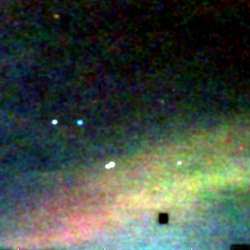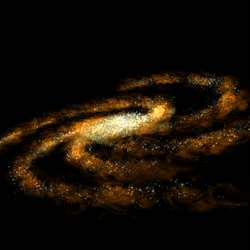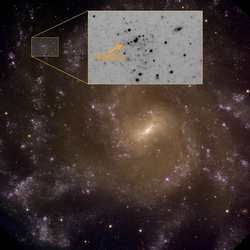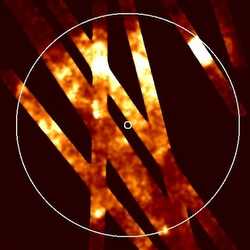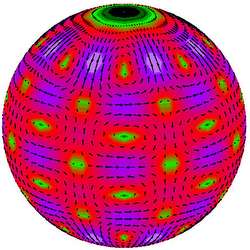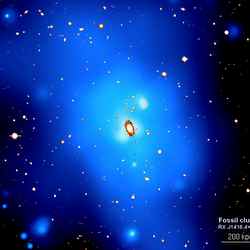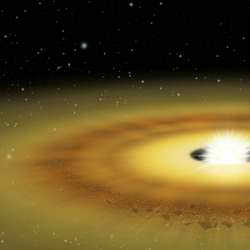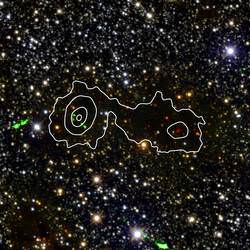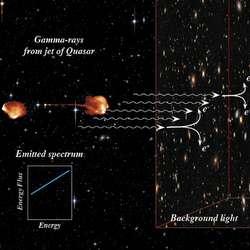
Artist’s impression of the Extragalactic Background Light emission and absorption. Image credit: HESS Collaboration. Click to enlarge
The Universe is filled with a diffuse glow of radiation coming from all the stars and galaxies. This cosmic fog is actually hard to detect because we have much brighter objects nearby that can wash it out; like how the city lights obscure the stars at night. One way to measure this radiation is by using the radiation from quasars, which are extremely bright and distant. The high-energy radiation from the quasars loses energy as it passes through this background radiation, and this can be measured.
All throughout space, a cosmic background light shimmers. Stars, galaxies – all kinds of sources – contribute to it; the light is their leftovers, in fact. Now, astrophysicists have discovered that this light is hardly as intense as anyone had guessed. The researchers used two distant quasars as “probes”, and recorded their gamma spectra using the H.E.S.S. telescopes in Namibia. These spectra turned out to be just a bit reddened; the background light seemed to only lightly obfuscate the quasars’ radiation. These observations do not just shed light on the background light – but on topics as great as the birth and development of galaxies (Nature, April 20, 2006).
Stars, galaxies, quasars, and many other objects contribute to the fog of radiation in the universe. It permeates all of intergalactic space; it is the “leftover” light that all these objects emit. Extragalactic background light – EBL – covers up epochs worth of stellar activity, from the time the first stars were created to the present. Scientists have been trying for a long time to measure this emission. Doing that directly is not easy, however, and extremely inaccurate, because Earth’s atmosphere, the Solar System, and the Milky Way send out radiation which gets in the way of observing weak EBL.
One way out of this problem is observing quasars – the cosmic energy factories which have a huge black hole in their middle. These “gravity traps” swallow up gas around them and spit some of it back as plasma, accelerated to nearly the speed of light. It is radiation bundled out of protons, electrons, and electromagnetic waves. Often, it can be hundreds of times wider than its mother galaxy. If this “quasar spray” heads in the direction of Earth, the radiation can appear quite strong – astronomers call this a “blazar”.
The two objects which H.E.S.S. researchers observed are both blazars. How to use them as probes? They send out very energetic gamma light particles, which lose strength on their way to Earth when they hit EBL photons. This causes the original blazar gamma spectrum to redden – like when the Sun nears the horizon at dusk and the Earth’s atmosphere disperses more of the blue part of the sunlight than the red. The thicker the atmosphere, the redder the sun. Reddening depends on the thickness of the medium. This fact is the key to investigating the composition of EBL.
Luigi Costamante of the Max Planck Institute for Nuclear Physics in Heidelberg says “the main problem is that energy distribution in quasars can take many different forms. Until now, we could not really say whether any observed spectrum looks red because it truly had a strong reddening, or if it was that way from the beginning.”
This problem has been solved thanks to the gamma spectra of two quasars — H 2356-309 and 1ES 1101-232. These objects are more distant than any sources observed until now. The sensitivity of the H.E.S.S. telescope made it possible to investigate them. It turns out that EBL’s intensity is not strong enough to redden quasar light; the spectra are too blue, and contain too many higher-energy gamma rays.
H.E.S.S. data has allowed the scientists to derive the maximum intensity of the diffused light. It is near the lowest limit resulting from the sum of the light of single galaxies visible in an optical telescope. That answers a question that has puzzled astronomers for years: is diffuse light created above all by the radiation from the first stars? The H.E.S.S. results seem to eliminate this possibility. There is also little room for contributions from other sources, like normal galaxies. Looking more closely at intergalactic space gives new perspectives on investigating gamma rays outside our own galaxy.
Original Source: Max Planck Society

